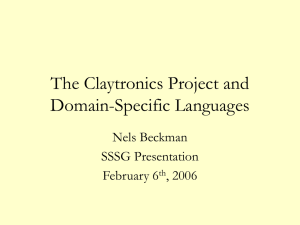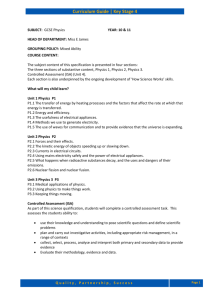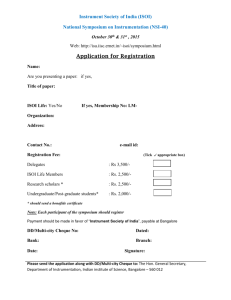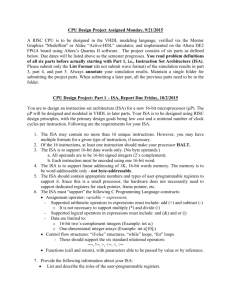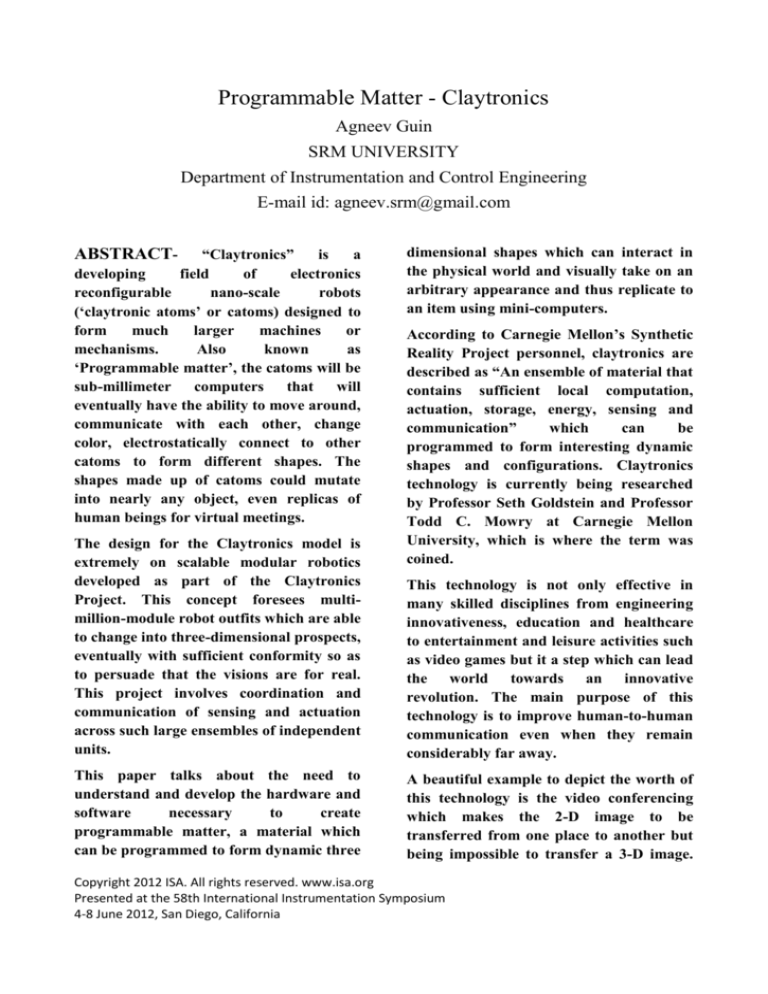
Programmable Matter - Claytronics
Agneev Guin
SRM UNIVERSITY
Department of Instrumentation and Control Engineering
E-mail id: agneev.srm@gmail.com
“Claytronics”
is
a
developing
field
of
electronics
reconfigurable
nano-scale
robots
(‘claytronic atoms’ or catoms) designed to
form
much
larger
machines
or
mechanisms.
Also
known
as
‘Programmable matter’, the catoms will be
sub-millimeter computers that will
eventually have the ability to move around,
communicate with each other, change
color, electrostatically connect to other
catoms to form different shapes. The
shapes made up of catoms could mutate
into nearly any object, even replicas of
human beings for virtual meetings.
ABSTRACT-
The design for the Claytronics model is
extremely on scalable modular robotics
developed as part of the Claytronics
Project. This concept foresees multimillion-module robot outfits which are able
to change into three-dimensional prospects,
eventually with sufficient conformity so as
to persuade that the visions are for real.
This project involves coordination and
communication of sensing and actuation
across such large ensembles of independent
units.
This paper talks about the need to
understand and develop the hardware and
software
necessary
to
create
programmable matter, a material which
can be programmed to form dynamic three
dimensional shapes which can interact in
the physical world and visually take on an
arbitrary appearance and thus replicate to
an item using mini-computers.
According to Carnegie Mellon’s Synthetic
Reality Project personnel, claytronics are
described as “An ensemble of material that
contains sufficient local computation,
actuation, storage, energy, sensing and
communication”
which
can
be
programmed to form interesting dynamic
shapes and configurations. Claytronics
technology is currently being researched
by Professor Seth Goldstein and Professor
Todd C. Mowry at Carnegie Mellon
University, which is where the term was
coined.
This technology is not only effective in
many skilled disciplines from engineering
innovativeness, education and healthcare
to entertainment and leisure activities such
as video games but it a step which can lead
the world towards an innovative
revolution. The main purpose of this
technology is to improve human-to-human
communication even when they remain
considerably far away.
A beautiful example to depict the worth of
this technology is the video conferencing
which makes the 2-D image to be
transferred from one place to another but
being impossible to transfer a 3-D image.
Copyright 2012 ISA. All rights reserved. www.isa.org
Presented at the 58th International Instrumentation Symposium
4-8 June 2012, San Diego, California
Using claytronics, the physical presence of
the person sitting beside can be felt
continents away. This system could also
have a role in telemedicine, allowing a
patient and doctor to be miles away and
examining the patient with claytronics
emulations. Thus, this is the next
unparalleled entity towards a Future
World.
‘claytronic’ model of himself move, gesture
INTRODUCTION
claytronic replica of the surgeon and would
and generally mirror all of his actions. It
would be as if a solid image is projected of
him. This technology would consent surgeons
to perform intricate surgery on enlarged
claytronic replicas of organs at the same time
the actual organs are being worked upon by a
enable the engineers to work remotely in
Atoms combine to form molecules and the
physically hostile environments.
micro or nano scale devices can combine to
form the shapes of physical entities. This
concept known as “programmable matter”
can collaborate to a material called Catoms or
“Claytronics atoms”. These Catoms are the
ones that contain sufficient local computation,
actuation,
storage,
energy,
sensing
and
communication which can be programmed to
form
interesting
dynamic
shapes
and
configurations. Claytronics is the way of
bringing
this
claytronics,
idea
millions
into
of
reality.
tiny
With
individual
devices- “claytronics atoms” or “Catoms”
would assemble into macro-scale objects,
connecting and disconnecting as they move.
The Claytronics seems to be a little
unbelievable and more than a sci-fi, however
work has already begun towards such
technology. The current large proof-ofconcept Catoms (measuring 4.4 centimeters)
connect and move via magnets, much like the
“replicating” robots, operating at scales where
electromagnetic or electrostatic connections
are used for reassembling. The Catoms could
have LCD or LED sufaces able to produce a
faintly glowing image, so that what appeared
to be a model made of millions of tiny
microbots.
Backed
by
the
microchip
manufacturer Intel, first generation Catoms,
measuring 4.4 centimeters in diameter and 3.6
The innovation in this field combines the
concepts of nanotechnology along with
telepresence. Small robots or ‘Catoms” of the
size of a few millimeters (or a few
nanometers) organize themselves into a shape
that is determined remotely. For example, an
individual located at a remote location have a
centimeters in height have been developed.
The main concerns for the development of
this technology are to create the basic
modular building block of claytronics known
as the claytronic atom or Catom, and to
design and write robust and reliable software
programs that will manage the shaping of
Copyright 2012 ISA. All rights reserved. www.isa.org
Presented at the 58th International Instrumentation Symposium
4-8 June 2012, San Diego, California
ensembles of millions of Catoms into
A large moving object such as a human
dynamic, 3-dimensional forms.
replica might have billions of Catoms. A
These Catoms which are ringed by several
system with a billion computer nodes is
electromagnets are able to move around each
something on the scale of the entire internet.
other to form a variety of shapes. Containing
Unlike the real internet, our thing is moving.
elementary processors and drawing electricity
This will require new schemes for quickly
from a board that they rest upon. So far only
organizing and reorganizing such a large
four Catoms have been operated together. The
computer network. A moving shape will
idea is to have thousands and millions of
make the Catoms to constantly and quickly
them moving around each other to form
change positions, breaking connections with
whatever shape is desired and to change
one set of Catoms and establishing new
color, also as required.
connections with others.
A. CATOMS
B. HARDWARE
The “Claytronic atom” or Catom would be
Claytronics hardware operates from macro
similar to the look of an atom and is preferred
scale designs with devices that are much
to be spherical in shape. A Catom would have
larger than the tiny modular robots that set the
no moving parts and each of the Catoms will
goals of this engineering research. Such
act as an individual and would be covered by
devices are designed to test concepts for sub-
electromagnets to attach itself to other
millimeter scale modules and to elucidate
Catoms.
crucial effects of the physical and electrical
forces that affect Nano scale robots. Catoms
Each Catom would contain a fairly powerful
processor and the Catoms surfaces would
have photocells to sense light and lightemitting diodes to allowing it to see and to
change color. The researchers are presently
trying to build a two-dimensional version,
with each Catom being a cylindrical device a
little more than an inch in diameter with its
side encircled by 24 electromagnets. It would
move by the rolling of the electromagnets one
created from the present research to populate
claytronic ensembles will be less than a
millimeter in size, and the challenge in
designing and manufacturing them draws the
CMU-Intel Research team into a scale of
engineering
built.
where
have
never
been
The team of research scientists,
engineers, technicians and students who
design these devices are testing concepts that
cross the frontiers of computer science,
over the other.
Copyright 2012 ISA. All rights reserved. www.isa.org
Presented at the 58th International Instrumentation Symposium
4-8 June 2012, San Diego, California
modular
robotics
and
systems
v.
nanotechnology.
i.
ii.
Cubes employ electrostatic latches to
demonstrate the functionality of a
Planar catoms test the concept of
device that could be used in a system
motion without moving parts and the
of lattice-style self-assembly at both
design of force effectors that create
the macro and nano-scale.
cooperative motion within ensembles
The
of modular robots.
Hardware Lab has prepared the path for
Electrostatic latches model a new
Carnegie
Mellon-Intel
Claytronics
development of a millimeter scale module
system of binding and releasing the
that will represent the creation of a self-
connection between modular robots, a
actuating Catom- a device that can compute,
connection that creates motion and
move and communicate at the nano-scale.
transfers
while
With the millimeter scale modular robot, the
of
Claytronic Hardware Lab will demonstrate
power
employing a
and
small
data
factor
a
the feasibility of manufacturing Catoms in the
powerful force.
quantities needed to produce dynamic 3iii.
Stochastic Catoms integrate random
motion
with
global
objectives
dimensional
representations
of
original
objects.
communicated in simple computer
language
iv.
to
form
B. 1. PLANAR CATOMS
predetermined
patterns, using a natural force to
The self-actuating, cylinder-shaped planar
actuate a simple device, one that
Catom tests concepts of motion, power
cooperates with other small helium
distribution, data transfer and communication
Catoms to fulfill a set of unique
that will be eventually incorporated into
instructions.
ensembles of nano-scale robots. It provides a
a
test bed for the architecture of micro-electro-
lighter-than-air
mechanical systems for self-actuation in
platform to explore the relation of
modular robotic devices. Employing magnetic
forces when electrostatics has a
force to generate motion, its operation as a
greater effect than gravity on a robotic
research instrument build a bridge to a scale
device, an effect simulated with a
of engineering that will make it possible to
modular robot designed for self-
manufacture
construction of macro-scale structures.
devices.
Giant
Helium
larger-than-life,
Catoms provide
Copyright 2012 ISA. All rights reserved. www.isa.org
Presented at the 58th International Instrumentation Symposium
4-8 June 2012, San Diego, California
self-actuating
nano-system
The planar Catoms operates on a two-
while also providing internal alignment and
dimensional plane in small groups of two to
stability along the cylinder's axis. At the base
seven modules in order to allow researchers
of the planar catom, the two heavier electro-
to understand how micro-electro-mechanical
magnet rings, which comprise the motor for
devices can move and communicate at a scale
the device, also add stability. To create
that humans cannot yet readily perceive -- or
motion, the magnet rings exchange the
imagine. These are approximately 45 times
attraction and repulsion of electromagnetic
larger in diameter than the millimeter scale
force
Catom for which its work is a bigger-than-life
catoms. From this conversion of electrical to
prototype.
kinetic energy, the module achieves a turning
with
magnet
rings
on
adjacent
motion to model the spherical rotation of
millimeter-scale catoms.
Fig. 1 Planar Catom V8
Fig. 2 Magnetic Rings from Planar Catom V7
The view of the stack of control and magnet-
The above picture shows two magnet rings
sensor rings of the Plnar Catom V8 is shown
from
above. Its solid state electronic controls ride
arrangement of their 12 magnets around
at the top of the stack. An individual control
individual driver boards and the coil design
ring is dedicated to each of the two rings of
for horse-shoe magnets.
magnet sensors, which ride at the base of the
A
module. Two thin threaded rods extend like
counterclockwise motion by a continuous
lateral girders from top to bottom through the
transfer of electro-magnetic force to achieve
outside edge to brace the rings. A central
the opposite motion in the other Catom. The
connector stack carries circuits between
planar Catom faces unique issues from
control and magnet rings, enabling easier
alignment and friction, which this image
handling and maintenance of components
suggests.
Planar
Catom
Copyright 2012 ISA. All rights reserved. www.isa.org
Presented at the 58th International Instrumentation Symposium
4-8 June 2012, San Diego, California
Catoms
sustains
displaying
a
clockwise
the
or
Fig. 3 Planar Catoms with LED
The picture above displays a planar Catom
Fig. 4 Electrostatic Latches
controller ring with light emitting diodes
It incorporates many innovative features into
(LEDs) arranged around its perimeter. This
a simple, robust device for attaching adjacent
board directs the two magnet driver boards
modules to each other in a lattice-style robotic
embedded in the magnet rings.
system. These features include a parallel plate
The custom design of the electronics achieves
capacitor constructed from flexible genderless
a very high level of capacity to guide the
electrodes of aluminium foil and dielectric
module’s
the
film to create an adhesion force from
smallest components commercially available,
electrostatic pressure. Its physical alignment
each controller board contains 5 layers of
of electrodes also enables the latch to engage
embedded microcircuits on 45 mm diameter
a mechanical shear force that strengthens its
acrylic boards. At this density of circuit
holding force.
design, wach of the two controller rings
Currently, the electrostatic latch is being
provides
the
tested on a modular Cube that is 28 cm on a
embedded instrumentation of a standard
side. Each star-shaped face supports passive
robotics controller package in 2/5th the space.
self-alignment of the link with a 45-degree
The resulting capacity of its boards enables
blade angle at the top of each comb on the
the module to carry on board all devices
face.
needed to manage its firmware, drivers and
disengagement with a five-degree release
24 magnets.
angle along the vertical lines of the faces.
performance.
approximately
B. 2.
Built
40
with
times
ELECTROMAGNETIC
LATCHES
The
design
also
supports
easy
B. 3. STOCHASTIC ATOMS
The module makes its decision by evaluating
the relation of its form in the instance of the
contact location to the ensemble's overall goal
Copyright 2012 ISA. All rights reserved. www.isa.org
Presented at the 58th International Instrumentation Symposium
4-8 June 2012, San Diego, California
for a predetermined shape. Based on this
evaluation, the module either forms a bond or
continues in motion. Computations within the
electronic module follow a simple program,
known as a graph grammar, which enables
each stochastic catom independently to
determine its location in relation to other
catoms in the ensemble - and in relation to a
predetermined shape into which the catoms
locate their positions from random motion.
for the electrostatic latch that has also been
engineered as part of this program.
B. 4. GIANT HELIUM CATOMS
A Giant Helium Catom (GHC) measures
Fig. 5 Cube Catoms
eight cubic meters when its light Mylar skin
The Cube also models the primary building
fills with helium to acquire a lifting force of
block in a hypothetical system for robotic
approximately 5.6 kilograms. This lift is
self-assembly that could be used for modular
necessary to elevate a frame of carbon fiber
construction and employ Cubes that are larger
rods and plastic joints, which contains the
or smaller in scale than the pictured device.
balloon and carries electronic sensors and a
communication
package
to
actuate
the
catom's motion and engage it with other
GHCs.
The
The design of a Cube, which resembles a box
with starbursts flowering from six sides,
emphasizes several performance criteria:
accurate and fast engagement, facile release
Giant
Helium
researchers
a
investigate
physical
Catom
macroscale
provides
to
clasps one module to another. Its geometry
affect
enables reliable coupling of modules, a strong
microscale devices. The GHC was designed
binding electrostatic force and close spacing
to approximate the relationship between a
of modules within an ensemble to create
near-zero-mass (or weightless) particle and
structural stability.
forces
instrument
and firm, strong adhesion while Cube latches
that
the force of electro-magnetic fields spread
C. SOFTWARE
across the surface of such particles.
B. 5. CUBES
In a domain of research defined by many of
the greatest challenges facing computer
A lattice-style modular robot, the 22-cubiccentimeter Cube provides a base of actuation
scientists and roboticists today is perhaps the
creation of algorithms and programming
language to organize the actions of millions
Copyright 2012 ISA. All rights reserved. www.isa.org
Presented at the 58th International Instrumentation Symposium
4-8 June 2012, San Diego, California
of
sub-millimeter
scale
Catoms
in
a
for it the metaphor of an Internet that sits on a
claytronics. As a consequence, the research
desk.
scientists and engineers have formulated a
In the Carnegie Mellon – Intel Claytronics
very broad-based and in-depth research
Software Lab, researchers address several
program to develop a complete structure of
areas of software development.
software resources for the creation and
C. 1.
operation of the densely distributed network
PROGRAMMING
LANGUAGES
of robotic nodes in a claytronic matrix. A
large, moving shape such as a human replica
Researchers in the Claytronics project have
might contain a billion Catoms. A system
also
with a billion computer nodes is something on
Distributed Predicates). These new languages
the scale of the entire Internet. Unlike the real
for declarative programming provide compact
Internet, our real thing is moving.
linguistic
A notable characteristic of a claytronic matrix
is its huge concentration of computational
created
Meld
and
structures
LDP
for
(Locally
cooperative
management of the motion of millions of
modules in a matrix.
C. 2.
power within a small space. For example, an
INTEGRATED
DEBUGGING
ensemble of catoms with a physical volume
of one cubic meter could contain 1 billion
In directing the work of the thousands to
catoms. Computing in parallel, these tiny
millions of individual computing devices in
robots
an
would
provide
unprecedented
ensemble,
claytronics
research
also
computing capacity within a space not much
anticipates the inevitability of performance
larger than a standard packing container.
errors and system dysfunctions. Such an
Because of its vast number of individual
intense computational environment requires a
computing
comparably
nodes,
the
matrix
invites
dynamic
and
self-directed
comparison with the worldwide reservoir of
process for identifying and debugging errors
computing resources connected through the
in the execution of programs.
Internet, a medium that not only distributes
data around the globe but also enables nodes
on the network to share work from remote
locations. The physical concentration of
millions of computing nodes in the small
C. 3. SHAPE SCULPTING
The team’s extensive work on Catom motion,
collective actuation and hierarchical motion
planning addresses the need for algorithms
that convert groups of Catoms into primary
space of a claytronic ensemble thus suggests
Copyright 2012 ISA. All rights reserved. www.isa.org
Presented at the 58th International Instrumentation Symposium
4-8 June 2012, San Diego, California
structures
for
building
dynamic,
3-
i.
This
technology
would
enable
dimensional representations. Such structures
engineers to work remotely in physically
work in a way that can be compared to the
hostile environments.
muscles, bones and tissues of organic
ii.
systems.
on enlarged claytronic replicas of organs,
Surgeons to perform intricate surgery
whilst the actual organs are being worked
C. 4. LOCALIZATION
The team’s software researchers are also
upon by a claytronic replica of the surgeon.
creating algorithms that enable Catoms to
iii.
localize their positions among thousands to
to 3-D faxing. A large number of sub
millions of other Catoms in an ensemble. This
millimeter robot modules form intelligent
relational knowledge of individual Catoms to
clay which can be reshaped via the external
the whole matrix is functional to the
application of mechanical forces. The clay
organization and management of Catom
can act as a novel input device, using inter
groups and the formation of cohesive and
module localization techniques to acquire the
fluid shapes throughout the matrix.
shape of a 3D object by casting.
A 3-D Fax machine is a new approach
The process of remotely reproducing a
C. 5. DYNAMIC SIMULATION
The simulated world of DPRSim manifests
facsimile of an object requires three phases:
characteristics
to
Acquisition, Transmission and Reproduction.
understanding the real-time performance of
In the first phase, the system senses the object
claytronic ensembles. Most important, the
and creates a digital representation of the
activities of Catoms in the simulator are
visible,
governed
physical
information is then transmitted to the remote
universe. Thus simulated Catoms reflect the
site. Finally, using the transmitted date, a
natural effects of gravity, electrical and
facsimile of the object is reconstructed at the
magnetic forces and other phenomena that
remote site.
will determine the behavior of these devices
Building a moving, sensing, color changing
in reality. DPRSim also provides a visual
replica of each person out of nanotech robots
display that allows researchers to observe the
makes every meeting a face-to-face meeting.
behavior of groups of Catoms.
This is the 3D Video conferencing. We feel
by
that
laws
are
of
crucial
the
D. APPLICATIONS
external
structure.
The
shape
that the person, continents away, as sitting
right beside you.
Copyright 2012 ISA. All rights reserved. www.isa.org
Presented at the 58th International Instrumentation Symposium
4-8 June 2012, San Diego, California
iv.
3D TVs and movies may also be
Unpredictable is the future though, changes in
possible using this claytronics.
the technology trends prepares everybody for
v.
tomorrow. Biotechnology, Genetics, Space
It might be useful for producing 3D
shapes in the computer-aided design process.
Science, Nanotechnology, Material Science,
Robotics and many more fields of technology
vi.
Claytronics cell phone might grow a
full-size keyboard, or expand its video display
as needed.
fiction in last 4 to 5 decades. Claytronics is an
exception as it never existed in science fiction
E. DISADVANTAGES
i.
managed to make their way out from science
as a science or technology until recent years,
With so many Catoms, the system will
have to compensate for the inevitable failure
and
yet
here
we
are
discussing
the
possibilities if programming matter.
of individual Catoms. Computers don’t deal
According to Moore’s Law, the transistors
well with failure.
count in an Integrated Circuit almost doubles
ii.
Algorithm
and
programming
the
combined motion of Catoms to form a 3D
every year. This shows the rapid development
in the electronics in the recent decades. If this
continues the concept of Claytronics will not
shape is a very ridiculous task.
be hard to achieve.
iii.
Even the nodes of the Internet have
REFERENCES
some addresses and accessing them is hard.
Accessing each Catom without any address is
At present, only four individual
Catoms are made to communicate with each
other. But, the thought of making billions of
Catoms to communicate may take a few
2. "Catoms: Moving Robots Without Moving
Parts," Kirby, Campbell, Aksak, Pillai,
Hoburg, Mowry, Goldstein, American
Association for Artificial Intelligence,
3. Meld:
Even
website
2005.
decades.
v.
project
http://www.cs.cmu.edu/claytronics/.
a very difficult task.
iv.
1. Claytronics
though
the
A
Declarative
Approach
to
mentioned
Programming Ensembles, InProceedings
applications are possible, the cost involving
of the IEEE International Conference on
the manufacturing of these Catoms may not
Intelligent Robots and Systems IROS '07,
be affordable.
Michael P. Ashley-Rollman, Seth Copen
F. CONCLUSION
Copyright 2012 ISA. All rights reserved. www.isa.org
Presented at the 58th International Instrumentation Symposium
4-8 June 2012, San Diego, California
Goldstein, Peter Lee, Todd C. Mowry and
Padmanabhan S Pillai, October 2007.
4. Collective Actuation, International Journal
of Robotics Research, Jason D. Campbell
and Padmanabhan Pillai, 2007.
5. "Integrated Debugging of Large Modular
Robot Ensembles," Benjamin D. Rister,
Jason Campbell, Padmanabhan Pillai and
Todd C. Mowry.
6. A Language for Large Ensembles of
Independently Executing Nodes- Michael
P. Ashley-Rollman, Peter Lee, Seth Copen
Goldstein, Padmanabhan Pillai, and Jason
D.
Campbell.
International
In Proceedings
Conference
of
on
the
Logic
Programming (ICLP '09), July, 2009.
7. "A
Modular
Robotic
System
Using
Magnetic Force Effectors," In Proceedings
of the IEEE International Conference on
Intelligent Robots and Systems (IROS
'07), Kirby, Aksak, Campbell, Hoburg,
Mowry, Pillai, Goldstein, October 2007.
8. "Hierarchical Motion Planning for Selfreconfigurable
Modular
Robots,"
In IEEE/RSJ International Confernce on
Intelligent Robots and Systems(IROS),
Preethi Srinivas Bhat, James Kuffner, Seth
Copen Goldstein,
and
Siddhartha S.
Srinivasa, October 2006.
Copyright 2012 ISA. All rights reserved. www.isa.org
Presented at the 58th International Instrumentation Symposium
4-8 June 2012, San Diego, California



